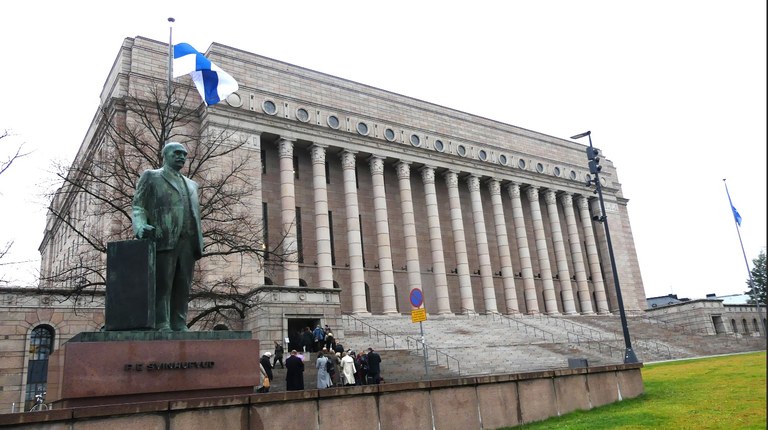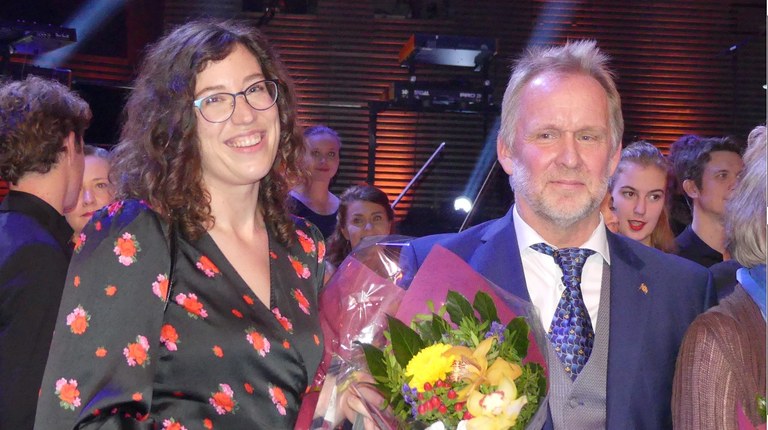Nordic cooperation spans everyday and fateful issues
“The Nordic Council deals with everyday issues of concern to the Nordic citizens,” Erkki Tuomioja told the media just before opening the 74th session in Helsinki on 1 November in his role as the Council President. Yet never before has a session been so dominated by big, existential issues.
Parliament House in Helsinki is only 190 kilometres from the Russian border. But none of the Nordic parliamentarians and government ministers gathered in the cube-shaped granite fortress with its monumental staircase and fourteen columns held back in their criticism of the Russian invasion of Ukraine.
 Parliament House in Helsinki with the statue of Pehr Svinhufvud, Finland's President between 1931 and 1937. When the February Revolution broke out in Russia in 1917, Svinhufvud became Prime Minister in the centre-right coalition government that declared Finland’s independence on 6 December 1917.
Parliament House in Helsinki with the statue of Pehr Svinhufvud, Finland's President between 1931 and 1937. When the February Revolution broke out in Russia in 1917, Svinhufvud became Prime Minister in the centre-right coalition government that declared Finland’s independence on 6 December 1917.
The invasion is brutal, reckless, cruel, illegal, aggressive, full-scale and unjust, to repeat just some of the many adjectives that were used during the debates. The war in Ukraine and the upcoming Nato membership for Finland and Sweden dominated more than the foreign policy debate. When other issues were debated, like a proposed council of ministers for infrastructure in the Nordic region, it was argued that the new security situation also impacted how roads and railways should be built.
Except for a group of Ukrainians protesting against Russia near the Mannerheim Monument, not much inside the Finnish parliament speak of the fact there is a war on in Europe. No armed guards are on duty inside, and all the doors are open to the Nordic guests. Documents from the daily work have been arranged on the top of a dresser, but it is still possible to read them – if you understand Finnish.
It is all an example of the trust the Nordic countries have in each other. For the 87 members of the Nordic Council, who during their terms manage to visit most of the Nordic parliaments, it makes the cooperation more concrete – a little like when the news from a country you have just visited becomes more interesting.
Climate change a fateful issue too
The cooperation is indeed about more everyday issues too – like the establishment of Nordic pilgrim paths – but there is a lot of focus on another fateful issue: climate change.
The Nordic Council of Ministers has agreed on a vision for the next eight years, in which the Nordic cooperation should focus on making the Nordic region green, competitive and socially sustainable.
Indeed, the Nordic region should be the world’s most sustainable and integrated region by 2030.
When the prime ministers agreed on this vision, the introduction was very poetic:
"The Nordic Region is our home, our world. The sea connects us, forests and lakes provide us with shelter and sustenance, fresh winds blow in over lush meadows, islands and skerries. We have mountains and fjords, glaciers and volcanoes, black sand and deep valleys. All over the Nordic Region, in towns and in the country, we seek to live in harmony with nature and create sustainable societies.”
With such floral language, you might think the vision would turn out to be equally airy and without substance. What does it really mean that the Nordic region should be the most integrated and sustainable region in the world?
What does the word “integrated” actually entail and what is in fact a region? Which other regions does the Nordic one compare itself to? The Benelux countries? The Baltic states? Is the EU a region? Or were the delegates thinking more about geographical entities like South-East Asia, Central America or Oceania?
Countries, not regions
If you take a look at the legislative history, it turns out the Nordics are not to be compared to other regions, but to three different groups of countries that each are in the lead when it comes to the three targets.
For the target of being green, the Nordic region should compare itself to Austria, France, Germany, Italy, Switzerland, the UK and New Zealand. The three first of these countries are in the reference group for all of the targets. The Netherlands, Belgium, Czech Republic, Estonia and Canada are in one or two of the remaining reference groups.
A total of 45 indicators – 15 for each target – have been chosen to measure whether things are developing in the right direction. Most of the indicators have a lower and upper limit and are divided into four colours -– green, yellow, orange and red – to make it easy to read the status quo. An arrow is used to indicate that things are developing in the wrong direction.
These are ambitious goals, no doubt, which at the start only had the colour green.
This is what the starting point looks like for the 15 environmental indicators:
The whole set of indicators can be found here:
As you can see, the Nordic region is ahead in only one area where development is also positive – the recycling of municipal waste. The indicator “ordinary birds on agricultural land” is also positive, but development is negative.
The budget for Nordic cooperation is around one billion Danish kroner (€134.4m), and you cannot do wonders with that. It is more important that the cooperation can spur the countries on to reach the goals together, but with measures being financed through the budgets of individual countries.
The Nordics can share standpoints and project the image of being a progressive region not least on the international stage. At the end of the day, it is about everyday issues and local initiatives, like the project that won this year’s Nordic Council Environment Prize:
The creation of wetlands in Mariehamn on Åland.

Johanna Mangström and Ulf Simelin.
Environmental coordinator Ulf Simelin and landscape architect Johanna Mangström were the proud recipients of the prize at Finlandia Hall.
“What’s unique with this project is that you reach the wetlands after just five minutes on a bike. That is where you can see what an ecosystem really is,” says Ulf Simelin.
Jetties have been constructed out over the water so that people can observe the different stages the wetlands go through over the seasons. School students can go out and analyse and look.
“When we released pike fry, children helped. This is all about creating interest and engagement in the next generation. It is so easy to access knowledge about nature. We have worked really hard to signpost everything there, so people know what to look for. People in Mariehamn also appreciate the sheer beauty of the place. That is how easy it is to please people! They like it when it is beautiful,” says Johanna Mangström.
- Group photo
-
of the delegates to the Nordic Council session which this year was helt in the Finnish Parliament House.
 Follow us on Facebook
Follow us on Facebook
